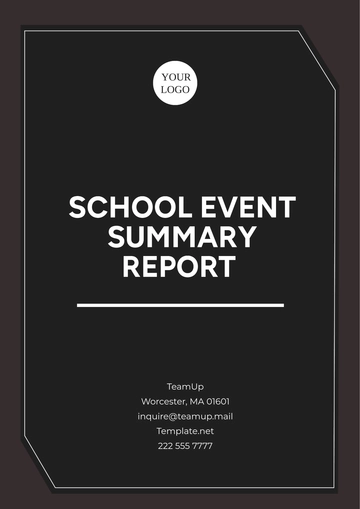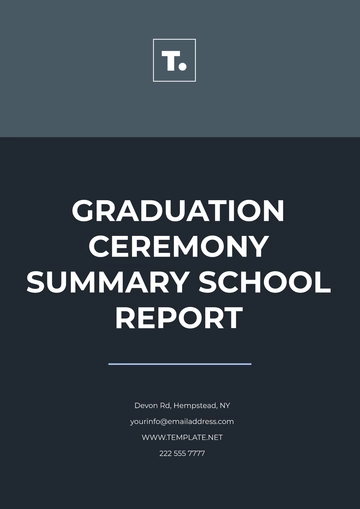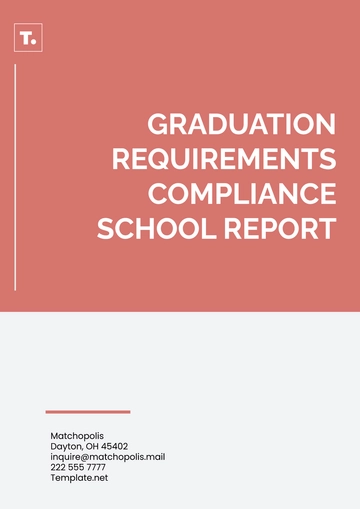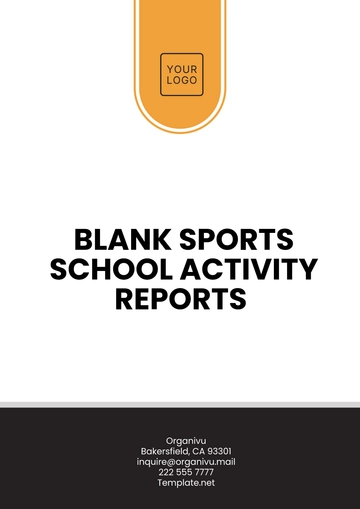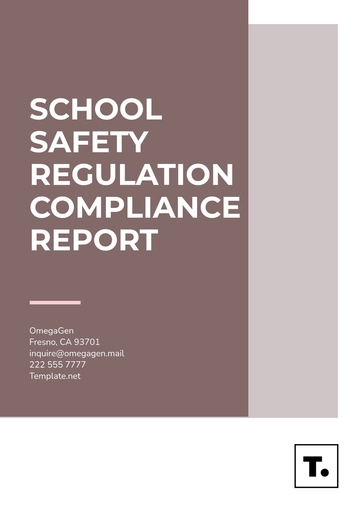Free Educational Field Report

Title: | "An In-Depth Study of Teaching Strategies and Student Engagement in High School Classrooms: A Field Report on Educational Practices in the 2050s" |
Prepared by: | [Your Name] |
Date: | October 21, 2054 |
I. Introduction
This report offers an in-depth analysis of observations and evaluations conducted during a recent field study of high school teaching practices across various classrooms. The study was designed to assess current teaching strategies, student engagement, and overall learning outcomes. The primary goal is to identify the most effective pedagogical methods and their impact on students' ability to retain information, participate actively, and demonstrate academic progress.
With educational systems rapidly evolving, particularly with the integration of digital tools and remote learning options, this study also aims to explore how these changes influence classroom dynamics and engagement levels. The insights gained from this study will help guide educators in implementing evidence-based strategies to foster more inclusive and effective learning environments.
II. Methodology
A. Research Design
The research employed a mixed-methods approach, combining qualitative and quantitative data collection techniques. A core component of the study was a longitudinal observation conducted over three months in five different high school classrooms. These classrooms were selected to reflect a diverse range of educational settings, including urban, suburban, and rural schools. The study also incorporated surveys administered to both students and teachers to provide a comprehensive understanding of the educational environment.
B. Data Collection
Observational Methods
Data were collected through a combination of non-participant observations, which allowed the researcher to unobtrusively capture the natural flow of classroom activities. Classroom observations focused on teacher-student interactions, the use of instructional technology, and overall student participation during different types of activities. A total of 120 hours of classroom observation were recorded.
Student and Teacher Surveys
Surveys were distributed to both students and teachers, asking them about their perspectives on teaching methods, classroom engagement, and the use of technology. The student survey included questions about their level of engagement, preferred learning styles, and the perceived effectiveness of various teaching strategies. Teachers provided feedback on the challenges and opportunities they encountered with student engagement and the integration of technology into their teaching practices.
Audio and Visual Recordings
In addition to field notes, audio and visual recordings of key teaching sessions were made to facilitate detailed analysis of non-verbal communication, including body language, student participation levels, and the use of digital tools in the classroom.
Data Analysis
The collected data were analyzed using thematic analysis, which involved coding and categorizing observations into emerging themes. Patterns in student behavior, engagement levels, and teacher strategies were identified and cross-referenced with survey results to conclude the effectiveness of different teaching methods.
For quantitative data, statistical analysis was used to measure correlations between teaching strategies and student engagement levels. Engagement scores, derived from survey responses, were compared to the types of activities observed to establish the effectiveness of each strategy.
III. Findings
A. Teaching Strategies
The study identified several teaching strategies that were commonly employed across the observed classrooms:
Interactive Lectures with Multimedia Presentations
Interactive lectures, enhanced by multimedia presentations such as videos, interactive slides, and live polls, were frequently used. These lectures were designed to provide students with visual and auditory cues to support comprehension. While students found these lectures engaging, the effectiveness varied depending on the level of student participation in the multimedia elements.
Group Discussions and Peer Review Activities
Group-based activities, including peer review sessions, collaborative problem-solving, and team-based projects, were prevalent in all observed classrooms. These activities encouraged active participation and peer learning, with students often reporting higher levels of engagement when working together in smaller groups.
Use of Technology for Instant Feedback
The use of digital platforms, such as interactive learning apps and online quiz tools, allowed for immediate feedback on student performance. This immediate feedback loop helped students understand their mistakes and improve their learning outcomes quickly. However, some students noted that the constant use of technology could be overwhelming and distracting, particularly during longer lessons.
B. Student Engagement
Activity and Engagement Levels
Activity | Engagement Level |
|---|---|
Interactive Lecture | Moderate |
Small Group Work | High |
Individual Assignments | Low |
Digital Learning Activities | High (if managed well) |
The findings revealed that group work consistently led to the highest levels of engagement, with students actively participating and collaborating. Conversely, individual assignments, while essential for assessing individual performance, often resulted in lower engagement levels unless paired with meaningful feedback or teacher interaction.
Students also expressed higher engagement with digital activities when technology was effectively integrated and not used excessively, suggesting that a balanced approach to tech use is crucial for maintaining focus.
IV. Discussion
The field study highlights several important insights about effective teaching practices in modern classrooms. One key observation is that interactive, participatory methods—such as group work and peer discussions—are the most effective in keeping students engaged and motivated. These methods facilitate peer-to-peer learning and encourage students to take more ownership of their learning process.
While technology can serve as a powerful tool for enhancing instruction, its use should be carefully considered. In some cases, technology introduced distractions, particularly when students were asked to switch between multiple digital platforms during a single lesson. Therefore, educators should aim to integrate technology meaningfully, ensuring it enhances rather than detracts from the learning experience.
Furthermore, the study suggests that differentiated instruction—tailoring teaching methods to accommodate diverse student needs—could further increase student engagement. Personalized learning paths, where students engage with content suited to their learning style (visual, auditory, kinesthetic), could be particularly beneficial in mixed-ability classrooms.
V. Conclusion
This field study underscores the significance of interactive and participatory teaching strategies in promoting student engagement and improving learning outcomes. Although the integration of technology offers substantial benefits in terms of instant feedback and dynamic lesson delivery, it must be managed carefully to avoid distraction. Group-based activities and peer collaboration have been shown to foster high levels of student involvement, and these should be considered fundamental components of classroom instruction.
For future research, it would be valuable to explore how adaptive learning technologies—which adjust the difficulty of tasks based on individual student performance—can be integrated into classrooms to personalize learning without overwhelming students.
VI. References
Smith, J. (2051). Effective Teaching Practices in Secondary Education. Educational Journal of the Future, 8(2), 102-115.
Brown, L., & White, K. (2053). The Role of Technology in Classroom Engagement. Journal of Educational Research and Innovation, 14(4), 231-246.
Miller, A. (2050). Strategies for Student-Centered Learning in the 21st Century. Education World Magazine, 18(1), 53-67.
Patel, R., & Thompson, C. (2054). Digital Tools in Education: Enhancing or Distracting? International Journal of Educational Technology, 5(3), 99-112.
- 100% Customizable, free editor
- Access 1 Million+ Templates, photo’s & graphics
- Download or share as a template
- Click and replace photos, graphics, text, backgrounds
- Resize, crop, AI write & more
- Access advanced editor
Create professional academic reports with Template.net's Educational Field Report Template. This fully customizable and editable template is perfect for documenting field research, observations, and findings. Easily tailored to suit your educational needs, it is editable in our Ai Editor Tool, ensuring a smooth and efficient report creation process. Download, personalize, and complete your field reports effortlessly.
You may also like
- Sales Report
- Daily Report
- Project Report
- Business Report
- Weekly Report
- Incident Report
- Annual Report
- Report Layout
- Report Design
- Progress Report
- Marketing Report
- Company Report
- Monthly Report
- Audit Report
- Status Report
- School Report
- Reports Hr
- Management Report
- Project Status Report
- Handover Report
- Health And Safety Report
- Restaurant Report
- Construction Report
- Research Report
- Evaluation Report
- Investigation Report
- Employee Report
- Advertising Report
- Weekly Status Report
- Project Management Report
- Finance Report
- Service Report
- Technical Report
- Meeting Report
- Quarterly Report
- Inspection Report
- Medical Report
- Test Report
- Summary Report
- Inventory Report
- Valuation Report
- Operations Report
- Payroll Report
- Training Report
- Job Report
- Case Report
- Performance Report
- Board Report
- Internal Audit Report
- Student Report
- Monthly Management Report
- Small Business Report
- Accident Report
- Call Center Report
- Activity Report
- IT and Software Report
- Internship Report
- Visit Report
- Product Report
- Book Report
- Property Report
- Recruitment Report
- University Report
- Event Report
- SEO Report
- Conference Report
- Narrative Report
- Nursing Home Report
- Preschool Report
- Call Report
- Customer Report
- Employee Incident Report
- Accomplishment Report
- Social Media Report
- Work From Home Report
- Security Report
- Damage Report
- Quality Report
- Internal Report
- Nurse Report
- Real Estate Report
- Hotel Report
- Equipment Report
- Credit Report
- Field Report
- Non Profit Report
- Maintenance Report
- News Report
- Survey Report
- Executive Report
- Law Firm Report
- Advertising Agency Report
- Interior Design Report
- Travel Agency Report
- Stock Report
- Salon Report
- Bug Report
- Workplace Report
- Action Report
- Investor Report
- Cleaning Services Report
- Consulting Report
- Freelancer Report
- Site Visit Report
- Trip Report
- Classroom Observation Report
- Vehicle Report
- Final Report
- Software Report





